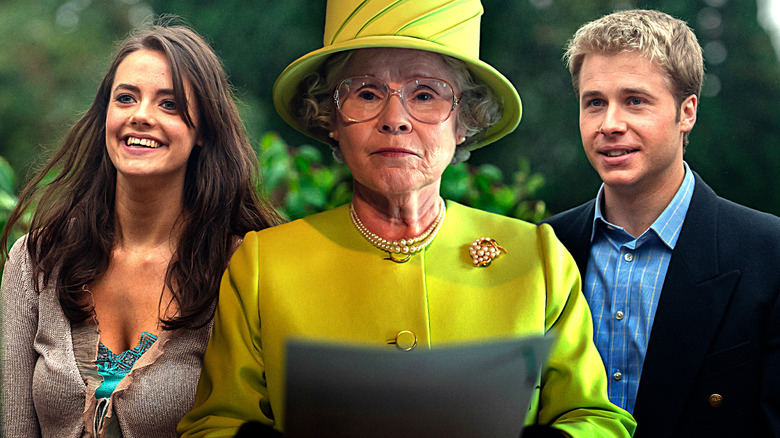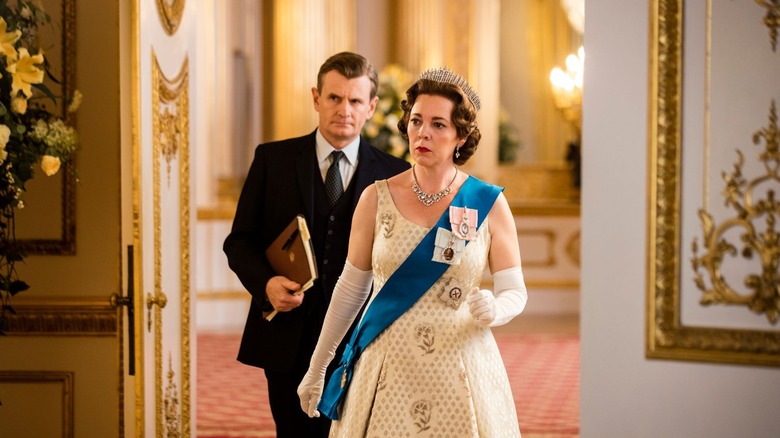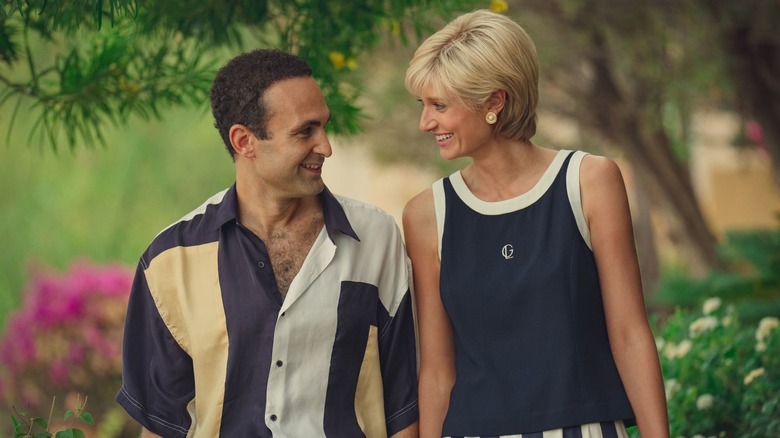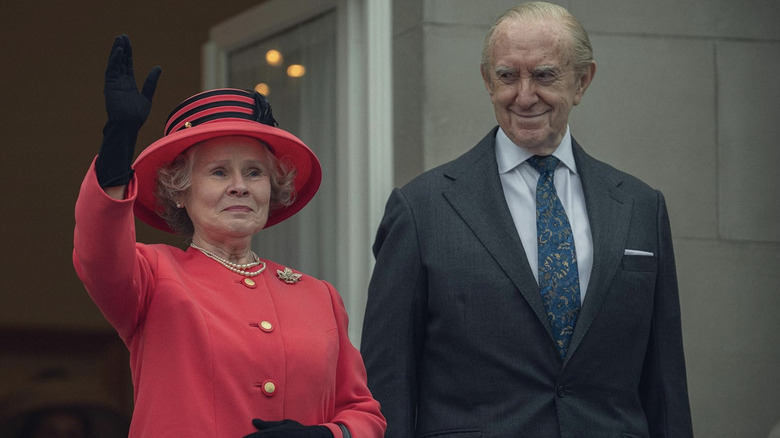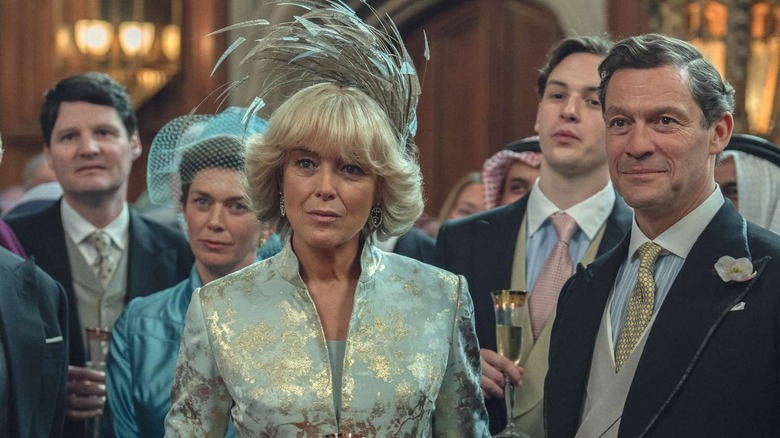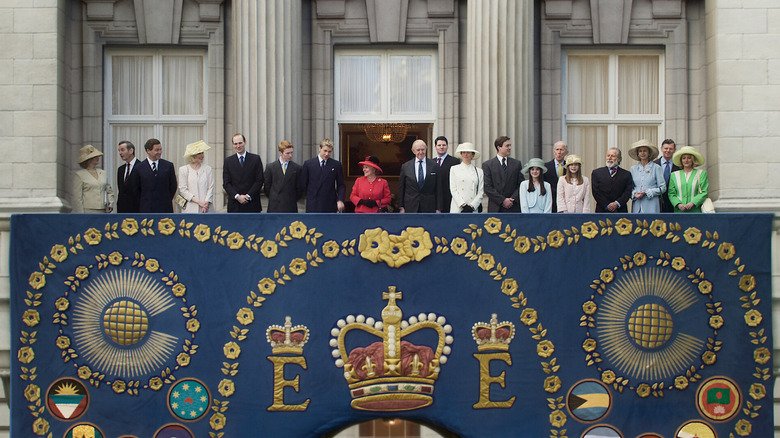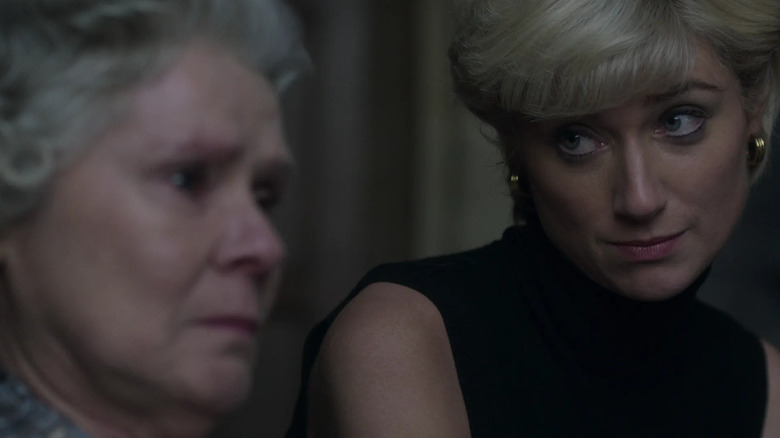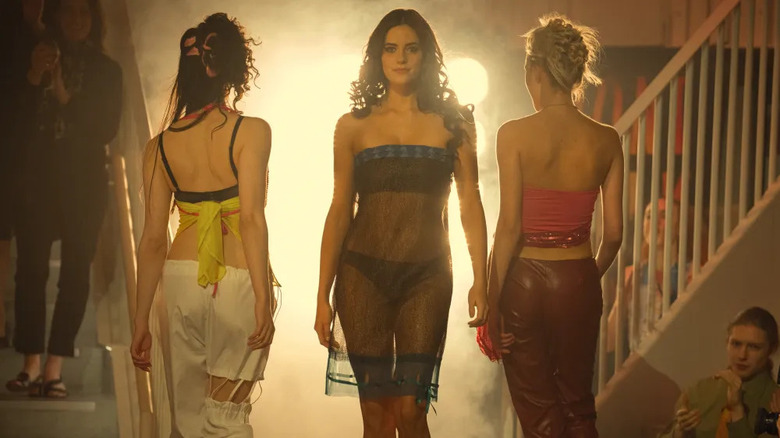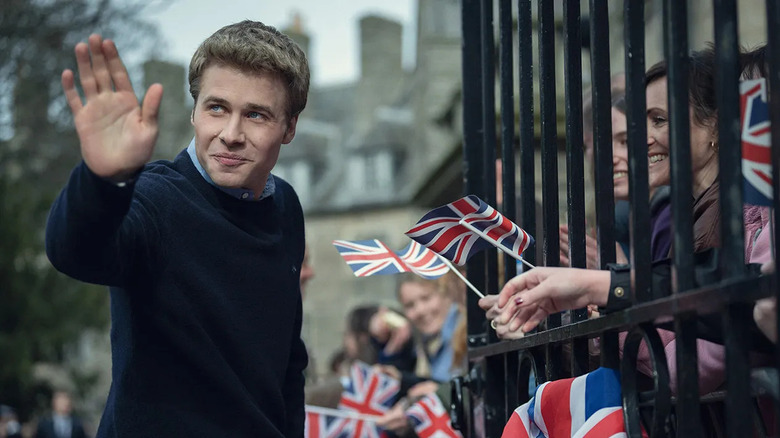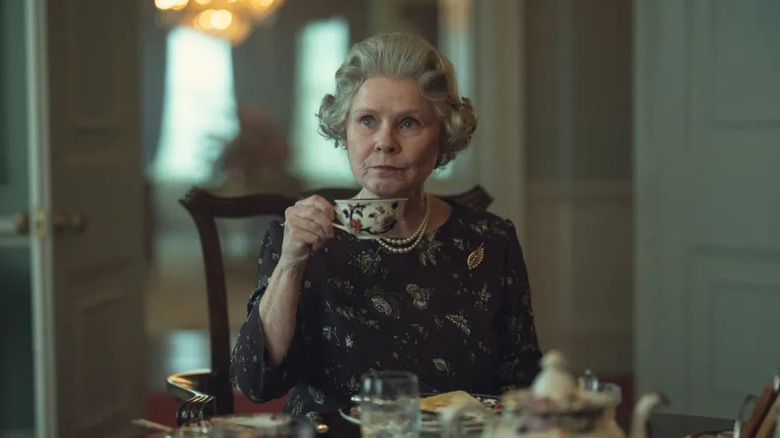The Ending Of The Crown's Series Finale Explained
Contains spoilers for "The Crown"
When "The Crown" premiered on Netflix back in 2016, it was one of the streamer's early prestige TV series, tackling — via historical fiction as opposed to documentary — the British monarchy around the midpoint of the twentieth century. Because the first two seasons of "The Crown" were set in a distant enough past, the audience wasn't necessarily familiar with the political intricacies and personal anecdotes that the show brought to life on the screen. Most viewers weren't alive for the coronation of Elizabeth II and don't have memories to compare to the series' recreation (or embellishment) of the actual events.
However, as the timeline of "The Crown" progressed from the late 1940s into the 1960s with Season 3 and the 1980s with Season 4, the audience's life experiences and collective memories began to catch up. This made it trickier for show creator Peter Morgan to creatively script situations that unfolded on television and in the tabloids, and that became even more true in Seasons 5 and 6, which take place in the 1990s and early 2000s. As "The Crown" drew to a close, the plot points alternated between painstaking duplications of notorious moments and the imagined private conversations and crises that may have occurred in between.
But beyond retelling the often soap opera-like story of the Windsors, "The Crown" used Elizabeth II as a living framework with which to examine the institution of the British monarchy and its place in a modern globalized world. Morgan pays off the questions he's been pondering for six seasons with an emotionally affecting finale that comes to some complicated conclusions about his stoic protagonist and her royal role.
What you need to remember about previous seasons of The Crown
Because seasons — and even individual episodes — of "The Crown" can stand on their own, it's certainly possible to pop in and out of the series as a casual observer. But most fans likely stuck with "The Crown" from the beginning, through multiple time jumps and rounds of recasting. Though Peter Morgan's project covers nearly 80 years of British history from the perspective of the extended royal family, there are plot lines and themes that run throughout, and many of these are tied up or alluded to in the last episode.
Seasons 1 and 2 largely concern themselves with Elizabeth Windsor's marriage to Philip Mountbatten, her ascension to the throne, and the young queen's relationship with an aging Winston Churchill. Princess Margaret emerges as a significant character whose perceived willfulness and selfishness often stand in contrast to Elizabeth's restraint and sense of duty. Seasons 3 and 4 see Elizabeth as a more established head of state who clashes with prime ministers, including Margaret Thatcher, while struggling to navigate the changing politics of the citizenry. Her middle-aged husband is unhappy, as is her son, Charles, the future king ... especially when he marries Diana Spencer instead of Camilla Parker-Bowles.
Season 5, which (for the most part) stars the current cast, revolves around Diana's divorce from Charles and emergence as a beloved public figure in her own right. Meanwhile, Charles and Camilla weather an embarrassing phone sex scandal, and we meet the Al-Fayed family. That tees up Season 6 to address the tragedy that continues to loom large over the British royals.
What you need to remember about the plot of the first half of Season 6
The death of Princess Diana was one of the biggest news stories of the century. Peter Morgan had already made an award-winning movie, 2006's "The Queen," that's exclusively about how Elizabeth managed the tragedy as a public figure and as an ex-mother-in-law. There would've been no way for Morgan to avoid it this time around, and since no actress plays Diana in "The Queen," there was still a story for him to tell. "The Crown" used the first four episodes of the sixth season to tell it.
Charles is eager to turn public opinion toward him and Camilla and away from Diana, which proves to be an impossible task. She's hounded by paparazzi when she and the boys venture to St. Tropez on the invitation of Mohammed Al-Fayed. When she and Dodi meet, he's engaged to another woman and she's just looking to have a good time. But his Anglo-obsessed father pressures him to woo the former princess, and the audience watches Morgan's version of the truth play out.
Diana and Dodi bond over their bad fathers (one of the show's recurring themes), and that bond evolves into a fling that Mohammed mistakes for something more serious. While William and Harry beg her to come home, Dodi feels obligated to bring her with him to Paris. Episode 3 stages their final hours together before the horrific accident that took both of their lives. Episode 4, which treads similar territory as "The Queen," shows Elizabeth, Charles, and the boys coping with the fallout.
What you need to remember about the plot of the second half of Season 6
The second half of the final season of "The Crown" actually accounts for a little more than half of the runtime. Its six episodes return the focus to the royal family, and to the three characters who did, do, and will wear the crown: Elizabeth, Charles, and William.
Charles struggles to parent his sons after Diana's passing, and he laments that her death will only delay his chances of being with Camilla. William and Harry are caricatures of the men they'll become. The former's uptight and burdened, the latter's reckless and unappreciated. William, now a reluctant teenage heartthrob, graduates from Eton and enrolls at St Andrews after a gap year. He's utterly distraught when he blows his shot with the so-called fittest girl on campus, Kate Middleton, whose mother has been not-so-secretly conspiring to make her daughter a most advantageous match. The literal prince charming gets another chance thanks to Kate's mom's meddling, and the two move in together, though Will realizes his responsibilities will always lie, first and foremost, with his family and the system.
Speaking of which, Elizabeth grapples with the monarchy's popularity, which is waning in comparison to the honeymoon phase of Tony Blair's tenure as prime minister. She allows a poll of the public, then is resolute about the royal family's place in British society despite the dispiriting results. Amid both Margaret's and the Queen Mother's failing health, and with her Golden Jubilee approaching, Elizabeth takes stock of her own life, from her one wild-ish night on VE day to her years as a young wife and mother.
What happens at the end of the series finale?
The series finale borrows its title, "Sleep, Dearie, Sleep," from the old Scottish dirge that Elizabeth chooses to have played on bagpipes at her state funeral. It's both an accurate reference and a fitting metaphor for the end of Elizabeth's life and the end of its dramatization on "The Crown."
The episode begins with Charles' proposal (sort of) to Camilla. Though he's a middle-aged man at this point, he must first get his mother's permission as well as the blessing of the Church of England. Charles argues it'd be good for the stability of the monarchy if he was married and happy, and after strategizing some caveats with her bishops, the Queen agrees. That means there's a wedding to plan, but there's also that funeral. Operation London Bridge is the codename for the goings-on that will go on when Elizabeth II inevitably dies. She's reluctant to delve into such sad business, but Philip suggests it might be cathartic.
He's right. The twin occasions "stir up" quite a lot in Elizabeth, as Philip puts it. She wrestles with her legacy and whether she's overstayed her welcome in her role as queen, and considers using her speech at Charles' reception to step down, thus making him king. Charles correctly surmises this might be the case. But after imagined conversations with her younger selves (played by a returning Claire Foy and Olivia Colman), Elizabeth realizes she's better suited to the job than anybody else in her family, and she comes to terms with the idea that her heavily orchestrated life of service came at the cost of privacy and freedom.
Where does The Crown leave its characters?
In the final moments of "The Crown," Elizabeth slowly walks out of view to the tune of "Sleep, Dearie, Sleep." This is a figurative nod to the Queen's death in 2022, but in the real timeline, she's decided to continue her reign and will rule for nearly another 20 years.
Tony Blair's popularity has all but evaporated as his support for the Iraq War turns out to have been unwise. His precipitous fall, from one of the most powerful leaders in the world to an incumbent unlikely to win his election, makes Elizabeth feel more confident about her own political instincts.
A few years earlier, Princess Margaret died after a debilitating series of strokes, followed within the month by the Queen Mother. Charles and Camilla are married, but Charles' ascension to the throne is postponed indefinitely. Camilla gently but firmly makes him face the fact that he hasn't been a perfect father to William and Harry. On that topic, William shows signs of becoming what Harry calls a company man who will act against his own judgment for the supposed good of the realm. The Queen says she's worried about the younger prince. His infamous Nazi costume is a subplot of the finale, and in response to the scandal, Philip suggests that military service should set him straight.
Philip, attuned to his wife's unspoken thoughts after so many years of marriage, supports her decision to stay on and makes some projections about the future of the monarchy. Though this scene takes place in 2005 and Philip won't die until 2021, the church feels like a liminal space, their conversation a final goodbye.
What does the ending mean?
The final season of "The Crown" takes some creative liberties that cross over from historical fiction to magical realism. Each time that boundary is broken serves as a last word on one of the show's many themes.
In the first half of the season, after Diana and Dodi have been killed, Charles and Elizabeth each have hallucinatory chats with the late princess. Mohammad Al-Fayed experiences the same phenomenon with his deceased son. These exchanges don't entirely absolve the living parties of their guilt, but they give everyone a chance to say what was left unsaid. Morgan relies on a similar device — the visiting apparitions of past versions of Elizabeth — to let the Queen say what she needs to say to herself.
Apart from character resolution, these fantastical scenes ask the audience to consider the relationship between the royal family, the press, the British government, and the public, as well as the relationship each member of the royal family has to the role they've been assigned by birth to play. These relationships are sometimes symbiotic and sometimes parasitic, and there lies the rub. With his last bit of dialogue, Philip tells Elizabeth that the system doesn't make sense anymore ... not to the outside world nor the remaining line of Mountbatten-Windsors. Nevertheless, it'll continue after they're buried under the church floor. "The Crown" seems to be admitting that the monarchy is outdated and possibly pointless or even detrimental whilst also arguing that there is something admirable about its persistence and devotion to the system.
How accurate is the ending of The Crown?
Though "The Crown" has been positively received on the whole, a frequent criticism that's been lobbed at the series is the not-always-so-fine line it draws between the documented truth and complete fabrication. In its final season (perhaps because it had to contend with recency), the show aimed for accuracy as much as possible, down to replicas of iconic fashions worn by the main characters. In addition to Harry's Nazi costume, Diana really was photographed wearing those boldly-patterned swimsuits and William did attend a fashion show at St Andrews in which Kate modeled the sheer, strapless dress that's shown in Episode 9. More substantive details are rooted in reality, too. Dodi purchased the Dis-Moi Oui ring, but likely never proposed, and the driver was intoxicated at the time of the crash. Mohamed Al-Fayed pushed conspiracy theories about that crash. Kate's mother, Carole, engineered her courtship with William to some extent. And a young Elizabeth and Margaret Windsor had a memorable night out on VE day in 1945 ... just not quite as depicted in flashback.
Some of what "The Crown" puts on screen can't be verified, such as sentiments spoken in private, say, between Diana and Dodi or William and Charles. Other plot points, small and significant, are wholly invented. In real life, Kate and Diana never had a chance meeting, and there's no proof that Elizabeth ever contemplated abdicating the throne as the show's queen does in the series finale.
What have the cast and crew said about the finale of The Crown?
Peter Morgan had two enormous challenges in conceiving the final season of "The Crown," one he saw coming and one that threw him for a loop. First, he had to represent the death of Princess Diana as tastefully as possible. "Oh, God, we were never going to show the crash," Morgan told Variety. He hadn't anticipated controversy about another tactic he took with his characterization of Diana, however. When word got out that Season 6 would include a depiction of the former princess as a ghost, a royal historian penned an essay, appalled by the creative flourish. "I never imagined it as Diana's 'ghost' in the traditional sense," Morgan explained. "It was her continuing to live vividly in the minds of those she has left behind."
The passing of Elizabeth II on September 8, 2022, led to a reworking of the series finale. Morgan said the sixth season was all but written when the queen died. The cast and crew were so moved by her funeral proceedings, that they decided to use the conceit of planning Operation London Bridge to acknowledge the end of Elizabeth's life and reign, even though the show hadn't caught up to the present moment.
Director of Photography Adriano Goldman filled Variety in on the decision to include all three actors who portrayed Elizabeth in the finale. He said it was director Stephen Daldry's idea to lean into the magical realism, thereby allowing for the three Elizabeths to share the screen. After working out a shooting schedule, the actors shot in person together.
Will there be more of The Crown?
Season 6 — which was always intended to be the final season — of "The Crown" ostensibly ends in 2005 with the wedding of Charles and Camilla. Elizabeth's story would continue until 2022, and the majority of characters on "The Crown" are alive to this day (and often, for better or worse, find themselves in the press). The series doesn't cover major royal events such as William and Kate's wedding and the birth of their three children, George, Charlotte, and Louis, or Harry and Meghan Markle's wedding and the birth of their son and daughter, Archie and Lilibet. Nor does it delve into the tension that's purportedly developed between the brothers, possibly stemming from Harry's decision to walk away from royal life. Most notably, Charles' coronation didn't make it into the show. One would think there's plenty more fodder for Peter Morgan to narrativize, should he want to stick with his favorite subject.
Though Morgan has returned to royal families and politics time and again, not only with "The Queen," but with myriad other screenwriting credits including "The Other Boleyn Girl," he's moving on from his longtime protagonist, Elizabeth II. Morgan confirmed to Tudum that he has no plans for "The Crown" to progress beyond Season 6. The finale gives his fictionalized version of Elizabeth a perfectly fitting send-off. "I think we all thought six seasons was perfect," he reflected, "two seasons for each queen."
